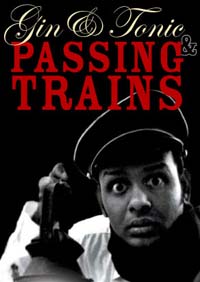-
Seven performances were featured in the studios, the programme booklet of Esplanade's Studio Theatre.[2] Gin and Tonic and Passing Trains (G&T&PT) was the first theatre installation in this studio series. Meyyappan portrayed Mr Jones who worked at the signal box based on Charles Dickens' classic ghost story The Signalman.[3] With timely bodily transformation, coordinated background music segments and intelligent lighting, this production was a remarkable enterprise.
-
Viewers of this production could choose to attend a visual narrating class conducted by Meyyappan at the Rehearsal Studio on 21 July 2007 before the evening performance. The visual narrative class went from 11am to 2pm at the Esplanade Rehearsal Studio. The experience of developing indexical details in a timely fashion was a rare learning opportunity. Some of the techniques included transition from one character to another via a 180 degree turn, a complementary gesture, a play of height difference, a shift of body position from left to right, a contrast of bodily movements, etc.
-
The learning experience that had little resemblance of the Indian dance-cum-story telling narrating style was relevant to the technical understanding of the evening performance. The predetermined back-and-forth pacing, moving from left-to-right-to-left, leisurely peering in-and-out of an imaginary door, and climbing up-and-down the imaginary stairs were technical. Eyes manoeuvring are valuable meaning-making tools in the performance and Meyyappan's left a lasting impression. Either combined with a cherubic smile, or paired with ghastly-looking lips his big round eyes made expert miming. His eyes indexed contrasting expressions by reinforcing meaning to his physical movements. In lieu of language, his facial features appeared like syllables that combined deftly with visual imageries in the visual narrative.
-
A delightful performance was delivered at the theatre studio. The active mental participation on the audience's part in developing the transparent meaning was an exciting experience. In comparison to audible theatre, the audience had to visualise intelligible details. The spoken words taken for granted were not part of the viewing package in the mime. This contrast fleshed out the difference between performing predominantly with linguistic intelligence and suppressing audible narration by means of non-linguistic intelligences in mime performance.
-
While there seemed to be no language barrier in G&T&PT the cultural barrier became visible where star gazing is concerned. As a prerequisite to understand arrow shooting, bull tossing, male-cum-female imagery, flying baby with wings and man wearing halo in the sky some knowledge of the English Zodiacs was necessary. Cultural difference remained a barrier to comprehend theatre performance. Young audience traveling with MRT (Mass Rapid Transit), cruises, planes, except locomotives might not have seen a signal box. The signal box would then be equated to a small abode, with the exclusion of loneliness in the wilderness. On the other hand, behavioural miming such as licking off food from the vest, spoon and fingers, munching in gusto as well as sipping tea to the last drop were seemingly transparent. Anybody equipped with basic cultural scripts would automatically comprehend such miming. That Mr. Bean was celebrated by adults and very young viewers, who either did not comprehend or have yet to acquire English, exemplified the point.
-
The role of the fingers was crucial in the mime. In different episodes, the fingers indexed utensils for eating, smoke from the train, stars in the sky, snow, bats, gin, tonic, stomach filling, falling out after accident, pieces of broken face hit by the train, etc. Significantly, the fingers also offered a helping hand in the descending of stairs, ladders, drinking, and eating. The narrating style delivered against minimal props was attractive. Apart from staying on throughout the performance, many in the audience laughed and sighed according to the different bodily antics. Imaginary indices such as mounting binoculars from the attic, descending onto the railway tracks, chasing birds, bitten by a bat, and identifying incoming trains were cleverly delivered.
-
The risk of a staccato story telling was evaded with a canvass of transformation. Lighting was the critical element in the transformation of the visual narrative. A bright light from the studio illuminated the break of day. Another green light beamed the ghostly appearance of different spirits at night. The yellow light bulb hanging from above lit a homey ambience of the signal box. The lowering of the bulb signalled the appearance of an imaginary attic. The techniques of multiple characterising were delivered skilfully with varying sounds drawing out moods ranging from joy, excitement, fear and despair throughout the performance. In a plural space of contrasting facial, physical, signatory, transitory, and illustrative indices, Meyyappan's performance was a captivating visual narrative.
-
Meyyappan's premeditated facial features and bodily gestures aptly provided a rich semiotics of visual communication. Movements and gestures became meaningful constructions that enhanced the ideational signals behind the facial expressions. Some of these signs could be decoded readily by most viewers. Failing to understand the signatory gestures, gazes, 180-degree turn and long stares would give rise to nagging mental gaps in the course of comprehending the mime. The experience from watching G&T&PT was mesmerising, refreshing, and paralleling at times. The corresponding body postures created an echoic parallel between the narrator and his audience. The experience formed an emphatic bodily complex between audience and actors, reflective of a personal physical response.[4]
Endnotes
[1] 'Gin and Tonic Flyer,' from Ramesh Meyyappan. n.d., online: http://www.rameshmeyyappan.com/ginandtonic.html, accessed 11 January 2010.
[2] the studios: The contemporary and exploratory in the studios, Singapore: The Esplanade Co. Ltd., 2007
[3] Ramesh Meyyappan has a first class honours degree from the Liverpool Institute of Performing Arts, http://www.rameshmeyyappan.com/index.html, accessed 11 January 2010.
[4]See Simon Shepherd, Theatre, Body and Pleasure, London: Routledge, 2006, pp. 8–9.
|
 Figure 1. 'Gin and Tonic Flyer.'[1]
Figure 1. 'Gin and Tonic Flyer.'[1]
